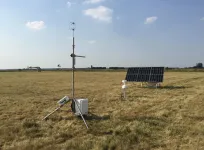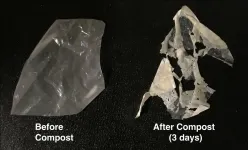(Press-News.org) What is the cost of 1 ton of a greenhouse gas? When a climate-warming gas such as carbon dioxide or methane is emitted into the atmosphere, its impacts may be felt years and even decades into the future - in the form of rising sea levels, changes in agricultural productivity, or more extreme weather events, such as droughts, floods, and heat waves. Those impacts are quantified in a metric called the "social cost of carbon," considered a vital tool for making sound and efficient climate policies.
Now a new study by a team including researchers from Lawrence Berkeley National Laboratory (Berkeley Lab) and UC Berkeley reports that the social cost of methane - a greenhouse gas that is 30 times as potent as carbon dioxide in its ability to trap heat - varies by as much as an order of magnitude between industrialized and developing regions of the world.
Published recently in the journal Nature, the study finds that by accounting for economic inequalities between countries and regions, the social cost of methane drops by almost a factor of 10 in sub-Saharan Africa and jumps by almost a factor of 10 for industrialized countries, such as the United States. The study calculated a global mean estimate of the social cost of methane of $922 per metric ton (not accounting for the inequity), decreasing to $130 per metric ton for sub-Saharan Africa and rising to $8,040 per metric ton for the U.S.
"The paper broadly supports the previous U.S. government estimates of the social cost of methane, but if you use the number the way it's typically used - as a global estimate, as if all countries are equal - then it doesn't account for the inequities," said Berkeley Lab scientist William Collins, one of the study's co-authors.
The lead authors of the study were David Anthoff, a professor in UC Berkeley's Energy and Resources Group, and Frank Errickson, a graduate student in the group at the time of the study. "The Biden administration's climate policy agenda calls for prioritizing environmental justice and equity. We provide a way for them to directly incorporate concerns for equity in methane emission regulations," said Errickson, now a postdoctoral fellow at Princeton University. "Our results capture that the same climate impact, when measured in dollars, causes a greater loss in well-being for low-income regions relative to wealthy ones."
Like the social cost of carbon, the social cost of methane is a metric that is not widely used by the public but is increasingly used by government agencies and corporations in making decisions around policies and capital investments. By properly accounting for future damages that may be caused by greenhouse gas emissions, policymakers can weigh present costs against future avoided harms. In fact, the recent White House executive order on the climate crisis established a working group to provide an accurate accounting of the social costs of carbon, methane, and nitrous oxide within a year.
"President Biden's action represents a much-needed return of science-based policy in the United States," said Anthoff. "Devastating weather events and wildfires have become more common, and the costs of climate impacts are mounting."
"The social costs of methane and carbon dioxide are used directly in cost-benefit analyses all the time," Collins said. "You have to figure out how to maximize the benefit from a dollar spent on mitigating methane emissions, as opposed to any of the other ways in which one might choose to spend that dollar. You want to make sure that you are not using a gold-plated band-aid."
Given the current estimate of global methane emissions of 300 million metric tons per year, that puts the annual social cost of methane at nearly $300 billion, said Collins, the head of Berkeley Lab's Climate and Ecosystem Sciences Division and also a professor in UC Berkeley's Earth and Planetary Science Department. "Wet areas will get wetter and dry areas dryer, so there's an increase in severity of storms and droughts," he said. "The cost would include all the things that flow from that, such as infrastructure damaged, increased expenditures around keeping places cool, health risks associated with heat, and so on."
While some methane comes from natural sources - mostly wetlands - about 60% of methane emissions come from human activity, including agriculture, fossil fuel production, landfills, and livestock production. It is considered a short-lived climate pollutant, staying in the atmosphere for only a decade or so, compared to more than 100 years for carbon dioxide.
"Given its potency as a greenhouse gas, regulating emissions of methane has long been recognized as critical component for designing an economically efficient climate policy," said Anthoff. "Our study updates the social cost of methane estimates and fills a critical gap in determining social costs."
Under the Obama administration, the price was estimated at about $1,400 per metric ton. The Berkeley researchers made a technical correction in accounting for offsetting influences on the climate system, arriving at global mean estimate of $922 per metric ton. "We're suggesting they slightly overestimated it," Collins said.
But more importantly, the uncertainty around the social cost of methane comes more from the social side, not the physics. "As a climate scientist, we've been busy trying to improve our estimates of the warming caused by methane," Collins said. "But it turns out the physics side is no longer the major source of uncertainty in the social cost of methane. It's now moved to the socio-economic sector, accounting for the damages and inequities."
How societies choose to develop in the future - such as expanding cities along coastlines or areas prone to flooding or wildfires, or moving away from such areas - are a big unknown. "If we choose mitigate climate change more aggressively, the social cost of methane drops drastically," Collins said.
"Continuing our work to further explore the relationship between climate change and socioeconomic uncertainties - not to mention the complex but important issues that arise when we account for equity - is a promising area for future research and policy exploration," said Anthoff.
INFORMATION:
Other study co-authors were Klaus Keller and Vivek Srikrishnan of The Pennsylvania State University. The research was supported by the National Science Foundation, the Sloan Foundation, and the Penn State Center for Climate Risk Management.
Founded in 1931 on the belief that the biggest scientific challenges are best addressed by teams, Lawrence Berkeley National Laboratory and its scientists have been recognized with 14 Nobel Prizes. Today, Berkeley Lab researchers develop sustainable energy and environmental solutions, create useful new materials, advance the frontiers of computing, and probe the mysteries of life, matter, and the universe. Scientists from around the world rely on the Lab's facilities for their own discovery science. Berkeley Lab is a multiprogram national laboratory, managed by the University of California for the U.S. Department of Energy's Office of Science.
DOE's Office of Science is the single largest supporter of basic research in the physical sciences in the United States, and is working to address some of the most pressing challenges of our time. For more information, please visit energy.gov/science.
Despite our efforts to sort and recycle, less than 9% of plastic gets recycled in the U.S., and most ends up in landfill or the environment.
Biodegradable plastic bags and containers could help, but if they're not properly sorted, they can contaminate otherwise recyclable #1 and #2 plastics. What's worse, most biodegradable plastics take months to break down, and when they finally do, they form microplastics - tiny bits of plastic that can end up in our oceans, fish, and even our bodies.
Now, as reported in the journal Nature, scientists at the Department ...
A study that appeared today on Current Biology sheds new light on the continental migrations which shaped the genetic background of all present Europeans. The research generates new ancient DNA evidence and direct dating from a fragmentary fossil mandible belonging to an individual who lived ~17,000 years ago in northeastern Italy (Riparo Tagliente, Verona). The results backdate by about 3,000 years the diffusion in Southern Europe of a genetic component linked to Eastern Europe/Western Asia previously believed to have spread westwards during later major warming shifts.
"By looking into the past of this particular individual, ...
Astronomers using data from NASA and the ESA (European Space Agency) telescopes have released a new all-sky map of the outermost region of our galaxy. Known as the galactic halo, this area lies outside the swirling spiral arms that form the Milky Way's recognizable central disk and is sparsely populated with stars. Though the halo may appear mostly empty, it is also predicted to contain a massive reservoir of dark matter, a mysterious and invisible substance thought to make up the bulk of all the mass in the universe.
The data for the new map comes from ESA's Gaia mission and NASA's Near Earth Object Wide Field Infrared Survey Explorer, or NEOWISE, which operated from 2009 to 2013 under the moniker WISE. The study, led by astronomers at the Center for ...
Substantial cuts in global greenhouse gas emissions could be achieved by raising water levels in agricultural peatlands, according to a new study in the journal Nature.
Peatlands occupy just three per cent of the world's land surface area but store a similar amount of carbon to all terrestrial vegetation, as well as supporting unique biodiversity.
In their natural state, they can mitigate climate change by continuously removing CO2 from the atmosphere and storing it securely under waterlogged conditions for thousands of years.
But many peatland areas have been substantially modified by human activity, including drainage for agriculture and forest plantations. This results in the ...
Scientists have found fragments of titanium blasting out of a famous supernova. This discovery, made with NASA's Chandra X-ray Observatory, could be a major step in pinpointing exactly how some giant stars explode.
This work is based on Chandra observations of the remains of a supernova called Cassiopeia A (Cas A), located in our galaxy about 11,000 light-years from Earth. This is one of the youngest known supernova remnants, with an age of about 350 years.
For years, scientists have struggled to understand how massive stars - those with masses over about 10 times that of the Sun - explode when they run ...
The diagnosis of diseases like cancer almost always needs a biopsy - a procedure where a clinician removes a piece of suspect tissue from the body to examine it, typically under a microscope. Many areas of diagnostic medicine, especially cancer management, have seen huge advances in technology, with genetic sequencing, molecular biology and artificial intelligence all rapidly increasing doctors' ability to work out what's wrong with a patient. However the technology of medical needles hasn't changed dramatically in 150 years, and - in the context of cancer management - needles are struggling to provide adequate tissue samples for new diagnostic techniques. Now researchers have shown that modifying the biopsy needle to vibrate rapidly ...
PHILADELPHIA--Piperlongumine, a chemical compound found in the Indian Long Pepper plant (Piper longum), is known to kill cancerous cells in many tumor types, including brain tumors. Now an international team including researchers from the Perelman School of Medicine at the University of Pennsylvania has illuminated one way in which the piperlongumine works in animal models -- and has confirmed its strong activity against glioblastoma, one of the least treatable types of brain cancer.
The researchers, whose findings were published this month in END ...
Scientists have spotted the largest flare ever recorded from the sun's nearest neighbor, the star Proxima Centauri.
The research, which appears today in The Astrophysical Journal Letters, was led by the University of Colorado Boulder and could help to shape the hunt for life beyond Earth's solar system.
CU Boulder astrophysicist Meredith MacGregor explained that Proxima Centauri is a small but mighty star. It sits just four light-years or more than 20 trillion miles from our own sun and hosts at least two planets, one of which may look something like ...
RESEARCH TRIANGLE PARK, N.C. -- With Army funding, scientists invented a way to make compostable plastics break down within a few weeks with just heat and water. This advance will potentially solve waste management challenges at forward operating bases and offer additional technological advances for American Soldiers.
The new process, developed by researchers at University of California, Berkeley and the University of Massachusetts Amherst, involves embedding polyester-eating enzymes in the plastic as it's made.
When exposed to heat and water, an enzyme shrugs off its polymer shroud and starts chomping the plastic polymer into its building blocks -- in the case of biodegradable plastics, which are made primarily of the polyester known as polylactic acid, or PLA, ...
Women at high risk of breast cancer face cost-associated barriers to care even when they have health insurance, a new study has found.
The findings suggest the need for more transparency in pricing of health care and policies to eliminate financial obstacles to catching cancer early.
The study led by researchers at The Ohio State University included in-depth interviews with 50 women - 30 white, 20 Black - deemed at high risk of breast cancer based on family history and other factors. It appears in the Journal of Genetic Counseling.
The researchers considered it a given that women without any insurance would face serious barriers to preventive care including genetic counseling and testing, prophylactic mastectomy and ...






